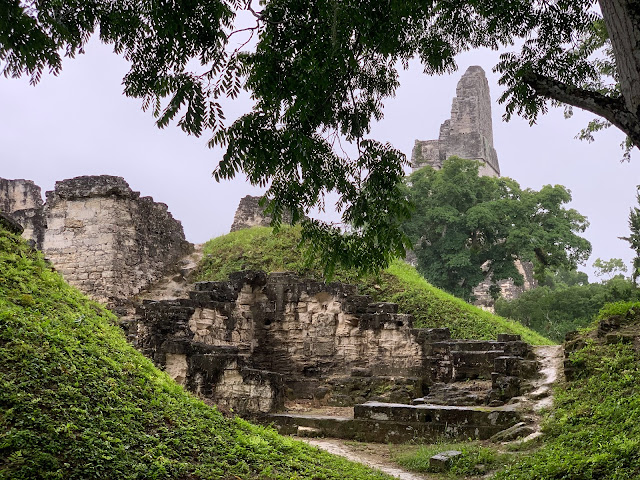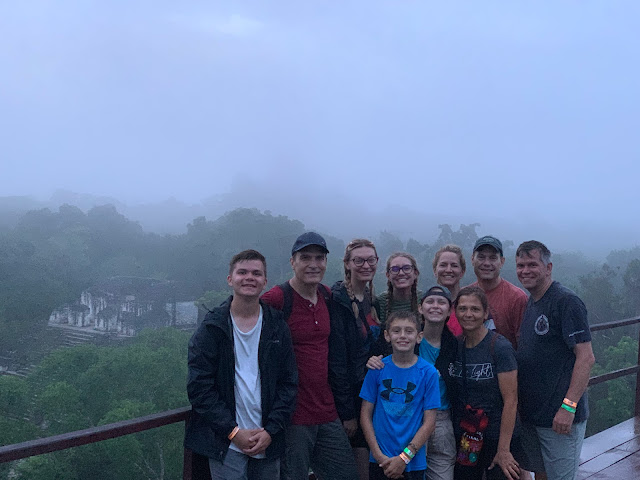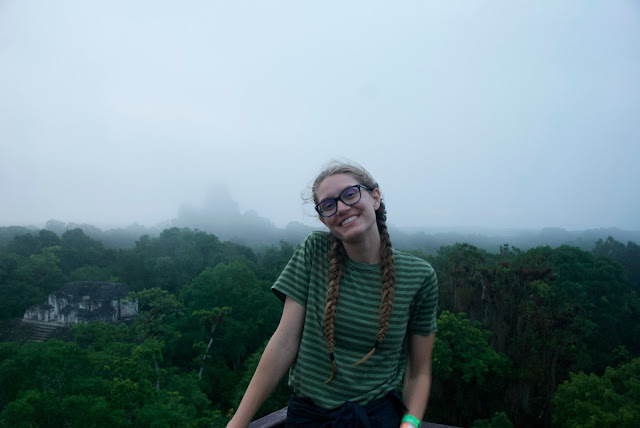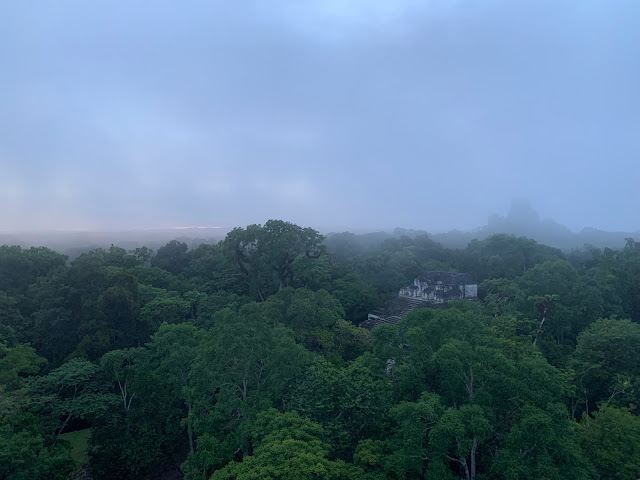Re-entering Tikal
On August 17, 2022, we finished our exploration of the ancient Mayan ruins of Tikal. The morning had been amazing! The afternoon was going to get wetter, creepier, and, eventually, darker. But still awesome.
During lunch, it started to pour rain, but we knew we were visiting during the rainy season, so we had taken precautions. We suited up in ponchos and headed out.
Twin Pyramid Complex (Group Q)
Our first stop was at "Group Q", a "Twin Pyramid Complex". The east pyramid was mostly uncovered, and its "twin" was still buried.
The East Pyramid had an impressive set of steles and altars out front.
This twin pyramid complex was built in 771 A.D. by Yax Nuun Ayiin to celebrate the end of the 17th "Katun" (20-year period) in the long count calendar. Their calendar dates were a pretty big deal to them, and they would construct these twin pyramids on these 20-year anniversaries.
It was raining when we got there, and the stairs were really steep, so if you want to see a 15-second video of how that felt, you can watch here.
Here we all are at the top of the pyramid.
 |
| East Pyramid, Group Q |
From the top, we could see Temple V over to the left, and the back of Temple I to the right (I'm pretty sure).
The drop-offs were pretty severe.
In this 20-second video, you get a sense of what it's like to look down from on top of this pyramid.
We had a strict policy of "no falling to your death", so people were careful going down the steps (in the rain).
We saw this bird next to the pyramid. It appears to be a Crested Guan.
Here you can clearly see pairs of glyphs on each row of the inscription, and perhaps remnants of the original paint on them.
It rained off and on through the afternoon, but since we were prepared for it, we didn't mind much. It sorted added to the rainforest mystique.
One of the great mysteries of these amazing Mayan cities is why they were abandoned. Tikal was occupied from perhaps as early as 1000 B.C., and buildings were constructed from around 100 A.D. to well into the 800s. However, the last dated stele in Tikal is 869, and the last anywhere in the Mayan world is 909. Something happened during that time to cause everyone to abandon the cities.
Many theories abound. There does appear to have been a drought at that time, and when agriculture suffers, it becomes difficult to sustain a population in a large city. There was also a big volcanic eruption around then that could have altered the weather. There is no particular evidence of disease I have heard of, but that could decimate a population as well. Some suggest that the area was stripped of too much of its vegetation, and deforestation ruined the climate there. It does not appear that war destroyed the cities, as they were not burned or sacked, but apparently just quietly abandoned.
One professor suggested that this all went down at the end of one of their major "long count calendar" milestones, which even among modern Mayans is thought of as a time to "scrap everything and start over." After the abandonment of the cities, there weren't really kings, but just "councils". So maybe, that theory goes, everyone agreed that all the kings were supposed to step down, government was supposed to disband, and everyone was supposed to find a new way to live, in which case people needed to revert back to agriculture to grow food for themselves.
Nobody really knows, and the glyphs don't seem to give the answer. Perhaps new evidence will come to light someday.
There behind Temple I was a a curious structure that has symbols that clearly come from Teotihuacan, a city in central Mexico, over 600 miles away.
David Stuart, an expert on Mayan glpyhs, deciphered the writings on Stele 31 at Tikal, which told about a Teotihuacan warlord named Siyaj K'ak' (aka "Fire is Born") conquering Tikal. He arrived in Tikal on September 13, 379 A.D. It is likely not a coincidence that the current ruler of Tikal at that time, "Great Jaguar Paw", died the same day.
Futhermore, just last year (in 2021), in analyzing LIDAR readings of the area, it was discovered that within Tikal is a pyramid complex (built about 250 A.D.) which is a miniature, 30%-scale version of a pyramid complex at Teotihuacan known as "La Ciudadela (or "The Citadel"). So these cities had been in communication for some time.
This particular edifice was built around 700 A.D.
Central Acropolis
Right next door was the sprawling Central Acropolis, which served as the city's "palace", where the rulers often lived.
(I wonder if this is an oven? I like to think it was a pizza oven...)
It was later expanded with several courtyards and a water reservoir.
The royal family apparently lived in some of these structures.
It still keeps people dry on occasion.
I guess this is the closet where they used to keep their spare rocks. (JK).This building is called "Mahler's Palace," named after an early explorer who used it as his base of operations when he visited there in 1895 and 1904. It was built by Tax Ain II, the 29th ruler of Tikal, who ascended to the throne in 768 A.D. He was also the one who built the twin pyramids in Group Q that we climbed earlier, and perhaps Temple V. (I'll bet the "9" symbol we saw on the stele there was part of "29", meaning, "29th ruler of Tikal").
Here you can see the ball court that was adjacent to Temple I. The game was tied in with their beliefs about the creation of the universe, and had to do with the rebirth of the corn god, so it was a big deal.
Some wonder if all these structures were built by SPACE ALIENS! According to Shaylee's picture, it appears that Jason is ONE OF THEM!! :O
 |
| Jared on the Central Acropolis, overlooking the Grand Plaza |
We walked through the Grand Plaza again, and got this close-up of Temple I, showing the daunting set of stairs to the top. (We were not allowed to climb this one).
One side of the Central Acropolis overlooks the Grand Plaza as well.
Temple I was still visible over the hill as we continued on our way.Toucans love the berries on this interesting bright red plant. (It looks like they picked this one clean).
Bat Palace
Our next stop was the "Palace of the Windows" (Palacio de las Ventanas), also known as the "Bat Palace" (Palacio de los Murciélagos)! ("Na-na na-na na-na na-na, Bat Palace!!")
We actually saw our first bats and scorpion spiders in the North Acropolis. But the bats in this palace were everywhere.
This 3-minute video starts with our first introduction to bats and scorpion spiders in the North Acropolis. You can actually hear the bats chirp as they use echolocation to find their way around (assuming your speakers and ears are working well enough). I have included a few slow motion clips I got of the bats flying around, too. I love how in one scene, Sharon is nervous about going in where there are more bats, and doesn't realize that they are flying around right behind her!
These flowers were cute.
Reyes showed us a termite colony on a tree. He said you can eat these termites and that they taste kind of like carrots. He ate some, and so did Linette and then several other people.
Sienna ate one, and it took a second...Here's a 2-minute video showing who ate termites.
I didn't eat any termites, because I don't especially like carrots. That and one other reason.
Reyes also showed us a big rectangular pit that was used for something.
Then he showed us a hole that he said was used to store grain in.
He went ahead and jumped in.
That seemed like a pretty good idea, so Jason jumped in, too.
There were scorpion spiders on the wall (including one you can see just up and to the left of Jared).
Mike climbed in a narrow slot and took pictures from there. I'm not sure that was any less sketchy.
Here's a video showing everyone jumping in what I call the Hole of the Scorpion Spiders. Mikayla has a classic line at the end when she says "No, thanks," and then says why she didn't jump in the hole.
(In case you didn't catch it, Mikayla says, "No, thanks, cuz I hate three things down there and I like most things up here.")
As it turns out, scorpion spiders are not scorpions nor spiders, but are a cousin to both. They do not have venom, which I didn't know until I got home, but apparently they do have a very painful bite. And they look creepy.
The Lost World
We finished walking to an area called "The Lost World" (El Mundo Perdido), containing 38 structures. This area was the first to be built in Tikal, and the last to be abandoned. The area was first occupied around 700 B.C., with the first masonry structures appearing around 600 B.C. Three temples were built about 100 A.D., and the complex reached its current size by 250 A.D.
Talud-Tablero Temple (Lost World)
The "Talud-Tablero Temple" (structure 5C-49) has layers that alternate between diagonal "Talud" sections and vertical "Tablero" sections. It is 22 meters (75 feet) tall, and was built in five phases, from the 3rd century A.D. to 700 A.D. It is the second largest structure in the Lost World complex.
This low platform (structure 5C-53) is on the west plaza, just west of the Great Pyramid. Details on the sides suggest that its construction was influenced by Teotihuacan. It appears to have been built about 600 A.D.
The Great Pyramid (Lost World)
The Great Pyramid is one of the most massive structures in Tikal, and the largest in the Lost World complex. It is 31 meters (101 feet) tall, and was built in five phases, starting in 600 B.C. (at a height of only 10 feet) and ending in 250 A.D. (at its current height of 101 feet).
The stairs on the east side (not restored) were used for astronomical purposes. We were able to climb the wooden staircase on the west side to reach the top.
From on top of The Great Pyramid, we could look out over the jungle canopy, see a bit of sunset in the distance, and also see the tops of several of the pyramids we had visited throughout the day.
Here is Temple IV, with clouds actively drifting across it.
Closer by is the Talud-Tablero Temple that we just came from.
As usual, the steps were steep, though in this case, part of these were still unexcavated.
The clouds were moving quickly, which caused the light to change from minute to minute.
Here is a 12-second time lapse video that Roger took with his GoPro to show the clouds moving by.
Since we were basically waiting for the sun to set, and this was our last thing to see, we just enjoyed resting from our hikes and the climb, and had fun watching the clouds drift by, and taking pictures of everyone endlessly in this magical environment. Here is our group.

The sun set, and it started getting a little darker. It was fun to watch the clouds turn purple and pink.

Jared stayed back to take one last look.
By then, it was very dark, especially down in the jungle. Reyes lit the way with his flashlight, and stopped to show us some carvings in one more building.
The wall of our hotel room had a Mayan-looking decoration in the shape of a huge jaguar head. And a foot.
We played a game of Sushi Go that evening before calling it a night. (I'm not sure if Linette looks so forlorn because she's so tired, or because I'm taking a picture. I'm suspecting the latter.)
Meanwhile, Shaylee was telling Jason a bedtime story. We all slept well that night.
I thoroughly enjoyed our huge day at Tikal. Reyes was an outstanding guide and in spite of a bit of rain in the afternoon, it would be hard to imagine the day going much better. We saw so many cool things and learned so much history. We saw lots of monkeys, coatimundis, interesting ants, creepy bats and even scorpion spiders! The cloud cover actually kept the heat from being oppressive, and we had a lot of fun together.
In the next episode, we do a less in-depth exploration of the Mayan ruins of Yaxha, 20 miles away.






















































































































































No comments:
Post a Comment